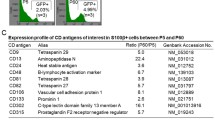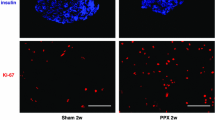Summary
The labelling index i.e., the proportion of cells in S phase of the cell cycle, has been calculated in cytospin preparations of rat anterior pituitary cells after labelling eitherin vivo orin vitro with the thymidine analogue bromodeoxyuridine (BrdU). The aims of this work were (1) to check whether enzymatic digestion interferes with the incorporation of BrdU into S phase cells and/or whether it has any deletereous effect on the immunohistochemical detection of cells that have already incorporated BrdU, and (2) to check the viability of simultaneous staining for BrdU and markers for the different types of pituitary cells in the cytospins. No statistical difference was found between the labelling index afterin vivo orin vitro labelling with BrdU. Identification of doubly-immunostained cells was straightforward and up to 40% of BrdU-labelled cells were immunopositive for pituitary hormones. It is suggested that cytospin preparations from biopsy samples may be used to study cellular proliferation without exposing the patient to the hazardous effects of BrdU infusion and without the interference of cell culture methods.
Similar content being viewed by others
References
Böswald, M., Harasim, S. &Maurer-Schultze, B. (1990). Tracer dose and availability time of thymidine and bromodeoxyuridine: application of bromodeoxyuridine in cell kinetic studies.Cell Tissue Kinet. 23, 169–181.
Carbajo-Perez, E. &Watanabe, Y. G. (1990). Cellular proliferation in the anterior pituitary of the rat during the postnatal period.Cell Tissue Res. 261, 333–8.
Carbajo-Perez, E., Motegi, M. &Watanabe, Y. G. (1989). Cell proliferation in the anterior pituitary of mice during growth.Biomed. Res. 10, 275–81.
Cocchia, D. &Miani, N. (1980). Immunocytochemical localization of the brain-specific protein S-100 in the pituitary gland of adult rat.J. Neurocytol. 9, 771–82.
Coltrera, M. D. &Gown, A. M. (1990) PCNA/cyclin expression and BrdU uptake define different subpopulations in different cell lines.J. Histochem. Cytochem. 39, 23–30.
Dada, M. O., Campbell, G. T. &Blake, C. A. (1984). Pars distalis cell quantification in normal adult male and female rats.J. Endocrinol. 101, 87–94.
Danova, M., Riccardi, A., Giordano, M., Girino, M., Mazzini, G., Dezza, I. &Ascari, E. (1988) Cell cycle-related proteins: a flow cytometric study in human tumors.Biol. Cell. 64, 23–8.
Dawson, A. E., Norton, A. J. &Weinberg, D. B. (1990). Comparative assessment of proliferation and DNA content in breast carcinoma by image analysis and flow cytometry.Am. J. Pathol. 136, 1115–24.
DeFazio, A., Leary, J. A., Hedley, D. W. &Tattersall, M. H. N. (1987) Immunohistochemical detection of proliferating cells in vivo.J. Histochem. Cytochem. 35, 571–7.
French, M., Magaud, J. P., Duhaut, P., Bryon, P. A. &Viala, J. J. (1990) Determination of plasma cell labelling index with bromodeoxyuridine using a double immunoenzymatic technique.Stain Tech. 65, 31–6.
Garcia, R. L., Coltrera, M. D. &Gown, A. M. (1989). Analysis of proliferative grade using anti-PCNA/cycliun monoclonal antibodies in fixed, embedded tissues. Comparison with flow cytometric analysis.Am. J. Pathol. 134, 733–9.
Goz, B. (1977) The effect of incorporation of 5-halogenated deoxyuridine into DNA of eukaryotic cells.Pharmacol. Rev. 29, 249–72.
Gratzner, H. G. (1982). Monoclonal antibody to 5-bromo- and 5-iododeoxyuridine: a new reagent for detection for DNA replication.Science 218, 474–5.
Hedley, D. W. (1989). Flow cytometry using paraffin-embedded tissue: five years on.Cytometry 10, 229–41.
Hunt, T. E. (1951). The effect of hypophyseal extract on mitotic activity of the rat hypophysis.Anat. Rec. 111, 713–25.
Hunt, T. E. &Hunt, E. A. (1966). A radioautographic study of the proliferative activity of adrenocortical and hypophyseal cells of the rat at different periods of the estrous cycle.Anat. Rec. 156, 361–8
Hymer, W. C., Evans, W. H., Kraicer, J., Mastro, A., Bavis, J. &Griswold, E. (1973). Enrichment of cell types from the rat adenohypophysis by sedimentation at unit gravity.Endocrinology 92, 275–86.
Inoue, K. &Kurosumi, K. (1981). Mode of proliferation of gonadotropic cells of the anterior pituitary after castration—immunocytochemical and autoradiographic studies.Arch. Histol. Jpn. 44, 71–85.
Kalbermann, L. E., Szijan, I., Jahn, G. A., Krawiec, L. &Burdman, J. A. (1979). DNA synthesis in the pituitary gland of the rat. Effect of sulpiride and postnatal maturation.Neuroendocrinology 29, 42–8.
Lloveras, B., Edgerton, S. &Thor, A. D. (1991). Evaluation ofin vitro bromodeoxyuridine labeling of breast carcinomas with the use of a commercial kit.Am. J. Clin. Pathol. 95, 41–7.
Mastro, A., Shelton, E. &Hymer, W. C. (1969). DNA synthesis in the rat anterior pituitary.J. Cell Biol. 43, 626–9.
Mcnicol, A. M. &Duffy, A. E. (1987) A study of cell migration in the adrenal cortex of the rat using bromodeoxyuridineCell Tissue Kinet. 20, 519–26.
McNicol, A. M., Shepherd, M. &Lane, D. P. (1991). Cell proliferation in pituitary adenomas: correlation with hormonal immunoreactivity.J. Endocrinol. Invest. 14 (suppl. 1) P14.
McNicol, A. M., Kubba, M. A. G. &McTeague, E. (1988) The mitogenic effects of corticotrophin-releasing factor on the anterior pituitary gland of the rat.J. Endocrinol. 118, 237–41.
McNicol, A. M., Murray, J. E. &McMeekin, W. (1990) Vasopressin stimulation of cell proliferation in the rat pituitary gland in vitro.J. Endocrinol. 126, 255–9.
Messier, B. (1969). Effect of exogenous thyroxine on3H-thymidine uptake in mouse pituitary gland.Acta Endocrinol. 61, 133–6.
Morstyn, G., Kinsella, T., Hsu, S. M., Russo, A., Gratzner, A. &Mitchell, J. (1984). Identification of bromodeoxyuridine in malignant and normal cells following therapy: relationship to complications.Int. J. Radiat. Oncol. Biol. Phys. 10, 1441–6.
Morstyn, G., Pyke, K., Gardner, J., Ashcroft, R., DeFazio, A. &Bhathal, P. (1986). Immunohistochemical identification of proliferating cells in organ culture using bromodeoxyuridine and a monoclonal antibody.J. Histochem. Cytochem. 34, 697–701.
Nemoto, R., Uchida, K., Hattori, K., Shimazui, T., Nishijima, Y., Saito, S., Koiso, K. &Harada, M. (1988). S phase fraction of human bladder tumor measured in situ with bromodeoxyuridine labeling.J. Urol. 139, 286–9.
Nemoto, R. Tohi, Koiso, K. &Harada, M. (1990). S-phase fraction of human prostate adenocarcinomas within vivo bromodeoxyuridine labeling.Cancer 66, 509–14.
Pan, S., Okazaki, Y. &Takemoto, T. (1990)In vivo cell kinetics studies of the duodenum during and after healing of cysteamine-induced duodenal ulcer in rats using bromodeoxyuridine incorporation.J. Gastroenterol. Hepatol. 5, 281–7.
Pomerat, G. R. (1941). Mitotic activity in the pituitary of the white rat following castration.Am. J. Anat. 69, 89–121.
Ramsdell, J. S. (1990). Thyrotropin-releasing hormone tuoliferation by blocking entry into S phase.Endocrinology 126, 472–9.
Rosental, D. G., Romano, M. I., Machiavelli, G. A., Grattone, M. L., Perez, R. L., Sterin-Speziale, N. &Burdman, J. A. (1989) Stimulation of cell proliferation in the anterior pituitary gland of the rat by indomethacin.Neuroendocrinol. Lett. 11, 333–8.
Silvestrini, R., Costa, A., Veneroni, S., Del Bingo, G. &Persici, P. (1988) Comparative analysis of different approaches to investigate cell kinetics.Cell Tissue Kinet. 21, 123–31.
Stepién, H. (1981) LHRH inhibits (3H)-thymidine incorporation by pituitary cells culturedin vitro.Endocrinology 109, 1784–6.
Thiry, M. (1988) Immunoelectron microscope localization of bromodeoxyuridine incorporated into DNA of Ehrlich tumor cell nucleoli.Exp. Cell. Res. 179, 204–13.
Watanabe, Y. G. &Carbajo-Perez (1990) Cell proliferation in pituitary monolayers as revealed by the BrdU labelling method.Biomed. Res. 11, 373–8.
Wright, N. A. &Appleton, D. R. (1980) The metaphase arrest technique. A critical review.Cell Tissue Kinet. 13, 643–63.
Author information
Authors and Affiliations
Rights and permissions
About this article
Cite this article
Carbajo, S., Gonzalez Del Pozo, F. & Carbajo-Perez, E. Quantification of the cellular proliferation on freshly dispersed cells from rat anterior pituitaries afterin vivo andin vitro labelling with bromodeoxyuridine. Histochem J 24, 137–143 (1992). https://doi.org/10.1007/BF01047463
Received:
Revised:
Issue Date:
DOI: https://doi.org/10.1007/BF01047463




